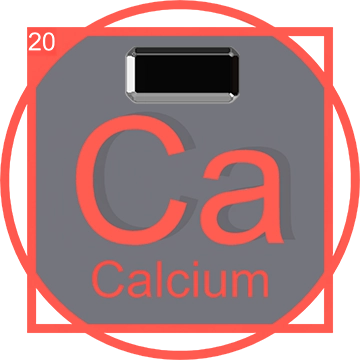The Essential Mineral: Calcium (Ca)
Introduction to Calcium
Calcium, symbolized as Ca, is a vital mineral predominantly known for its crucial role in bone health and physiological processes within the human body. But its significance extends beyond biology into various scientific and industrial domains.
Discovery of Calcium

Calcium was first isolated by Sir Humphry Davy in 1808 through the electrolysis of a mixture of lime (CaO) and mercuric oxide. This discovery marked a significant advancement in the study of elements and their isolation techniques.
Calcium in the Periodic Table
Occupying position 20 in the periodic table, Calcium is a member of Group 2, known as the alkaline earth metals. This group is characterized by its elements' shared properties like lustrous silver surfaces and low electron affinity, making them highly reactive, especially with water.
Chemical and Physical Properties of Calcium

Calcium is a soft gray alkaline earth metal, and it's the fifth most abundant element by mass in the Earth's crust. The element is essential in forming limestone and is widely used in construction and medicine.
Biological Importance of Calcium
In the biological context, Calcium plays a pivotal role in various cellular processes. It helps in the transmission of nerve impulses, contraction of muscles, and coagulation of blood. Its most renowned function is in the formation and maintenance of bones and teeth, making it a critical dietary requirement.
Calcium's Role in Industry

Beyond its biological importance, Calcium finds extensive use in the metallurgical industry as a deoxidizer and decarbonizer for various metal alloys. It is also used in the manufacture of cements and mortars in the building sector.
Health Benefits and Dietary Sources
Calcium is crucial for maintaining bone density and preventing osteoporosis. Dietary sources of Calcium include dairy products like milk and cheese, green leafy vegetables, and fortified cereals.
Conclusion
From strengthening bones to facilitating industries, the role of Calcium in both natural and human-made environments is undeniable. As a cornerstone of the alkaline earth metals, it continues to be a subject of extensive study in multiple scientific disciplines.
How Calcium is Produced
Calcium is primarily extracted from minerals such as calcite, limestone, and gypsum which are among the most prevalent natural sources of this element. These minerals are primarily composed of calcium carbonate (CaCO3), which is processed in various ways to produce metallic Calcium. One common method involves the reduction of lime (calcium oxide, CaO) with aluminum at high temperatures, a process that yields pure Calcium metal and aluminum oxide as a byproduct.
Major Calcium Mines and Associated Resources

Significant calcium mines are located globally with major deposits found in the United States, Russia, China, and Mexico. In these mines, Calcium is often found alongside resources like fluorite, barite, and gold. These associated minerals often occur together due to their similar geological formations.
One of the noteable Calcium mines is the Phosphate Mine in Bir Mezoui, Beni Mellal-Khenifra in Morocco in the documentation is correct as yet to be fully verified.
Modern Uses of Calcium

Today, Calcium is extensively used in the construction industry in the form of calcium carbonate (limestone) and gypsum (plaster) for building materials. It is also a key component in steel manufacturing as a deoxidizer, and in the purification of iron. In the environmental sector, Calcium compounds are used to neutralize acidic conditions in both soil and water. Additionally, Calcium salts are essential in food, pharmaceuticals, and agriculture for their nutritional and preservative qualities.
The Future of Calcium in Science and Technology

Looking forward, the role of Calcium could expand significantly with advances in technology. Research is currently underway exploring the use of Calcium-based materials in energy storage, particularly in batteries. Calcium offers a potential alternative to lithium with advantages in abundance and cost. Moreover, in the field of biotechnology, Calcium phosphate is being investigated for use in advanced bone repair techniques, offering more effective solutions for osteoporosis and bone fractures.
Conclusion
Calcium's role extends far beyond its traditional uses in construction and nutrition. As scientific research progresses, the potential applications of this versatile mineral are expanding, promising to play a significant part in future technological and medical advancements.










